The Correlation Between Team Leadership and Patient Care Quality
VerifiedAdded on 2023/06/10
|8
|2515
|96
Essay
AI Summary
This essay examines the correlation between effective team leadership and improved patient care within the healthcare industry. It highlights the importance of leadership skills, supported by leadership theories, models, and practical examples. The essay discusses how strategic thinking, effective communication, and inclusive leadership styles contribute to enhanced patient safety, clinical effectiveness, and patient experience. It references NHS guidelines and the healthcare leadership model, emphasizing the role of leaders in inspiring shared purpose, leading with care, evaluating information, connecting services, and developing team capabilities. Examples from hospital hierarchies, nursing management, and trauma centers illustrate the practical application of leadership principles in ensuring quality patient care and organizational success. The conclusion emphasizes the responsibility of healthcare professionals in leadership roles to foster a collaborative environment that prioritizes patient well-being.
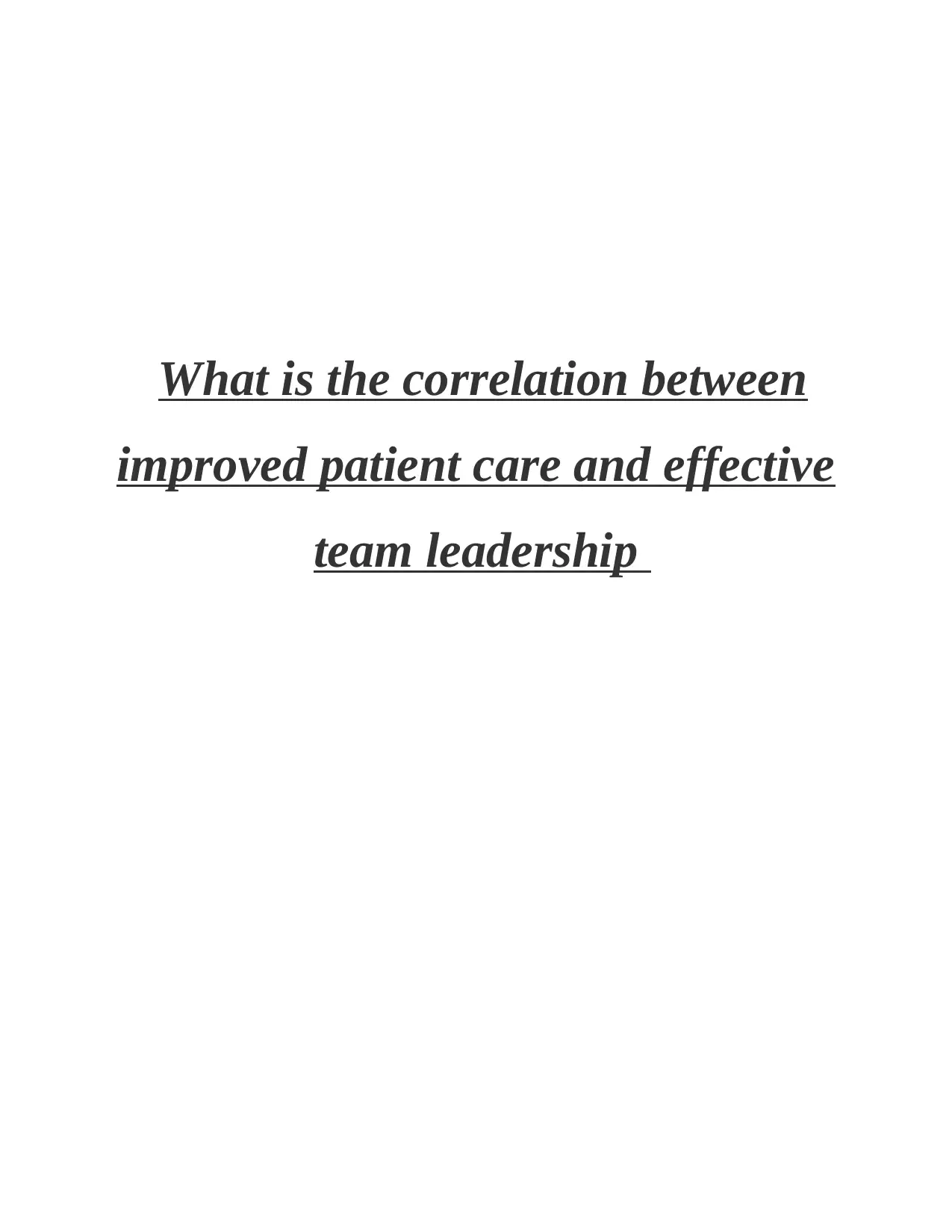
What is the correlation between
improved patient care and effective
team leadership
improved patient care and effective
team leadership
Secure Best Marks with AI Grader
Need help grading? Try our AI Grader for instant feedback on your assignments.
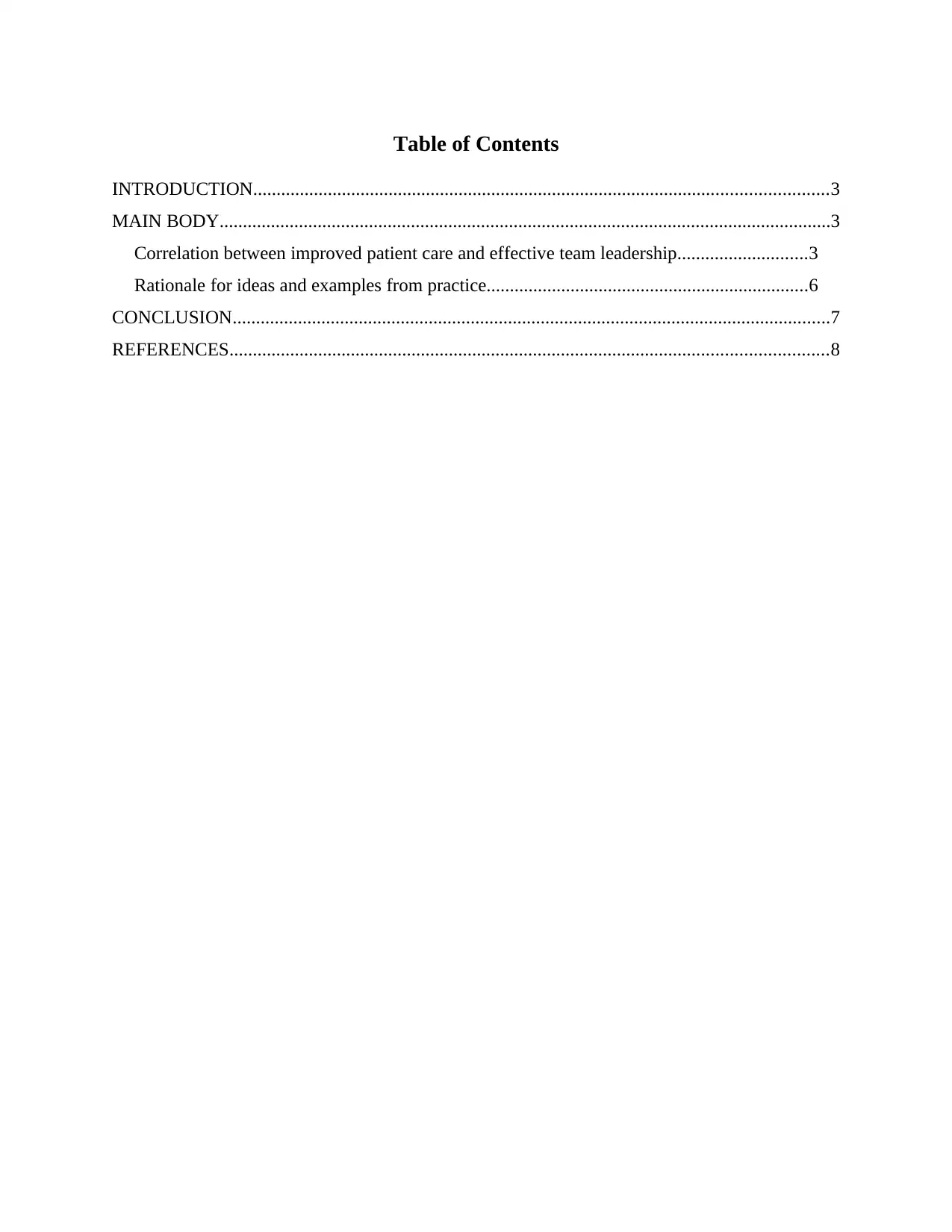
Table of Contents
INTRODUCTION...........................................................................................................................3
MAIN BODY...................................................................................................................................3
Correlation between improved patient care and effective team leadership............................3
Rationale for ideas and examples from practice.....................................................................6
CONCLUSION................................................................................................................................7
REFERENCES................................................................................................................................8
INTRODUCTION...........................................................................................................................3
MAIN BODY...................................................................................................................................3
Correlation between improved patient care and effective team leadership............................3
Rationale for ideas and examples from practice.....................................................................6
CONCLUSION................................................................................................................................7
REFERENCES................................................................................................................................8
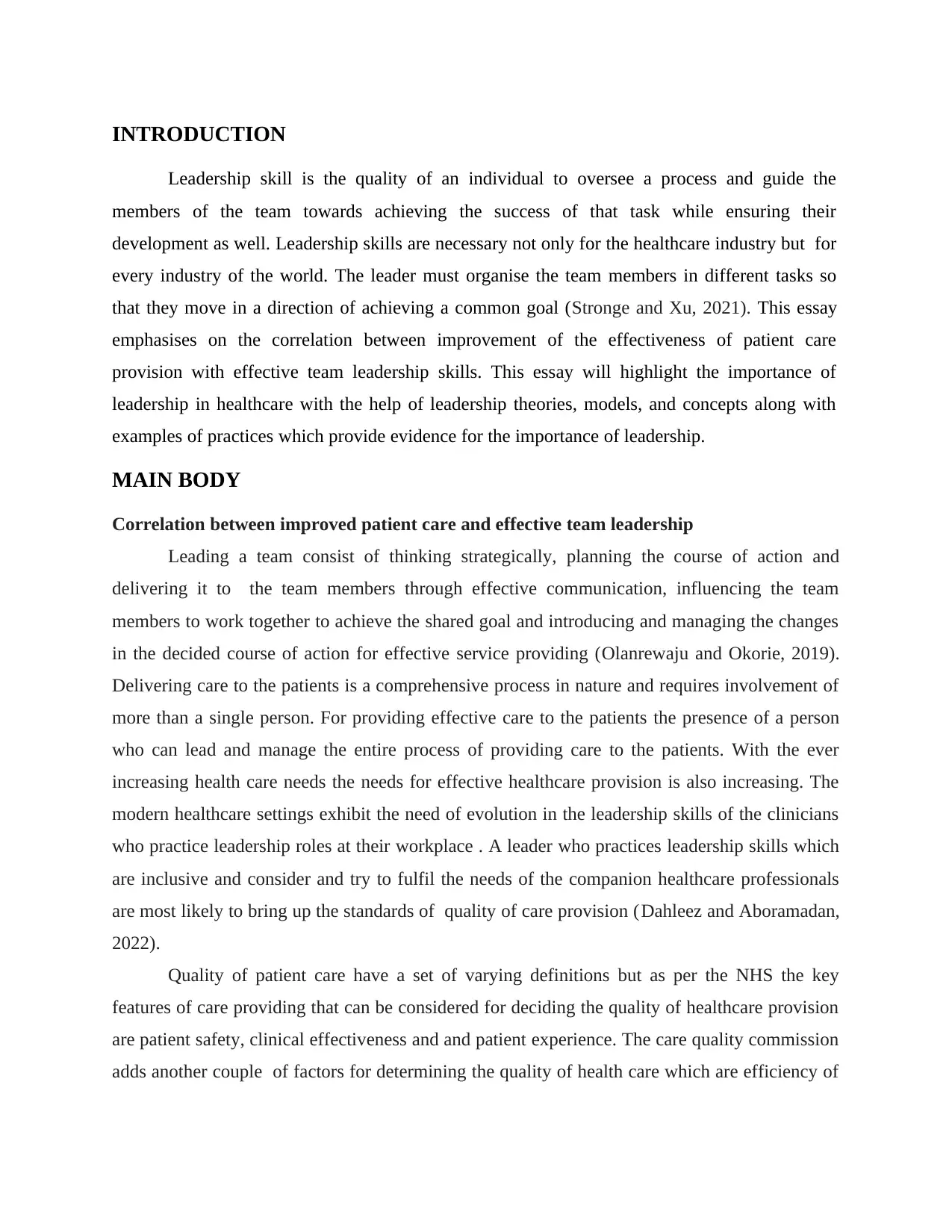
INTRODUCTION
Leadership skill is the quality of an individual to oversee a process and guide the
members of the team towards achieving the success of that task while ensuring their
development as well. Leadership skills are necessary not only for the healthcare industry but for
every industry of the world. The leader must organise the team members in different tasks so
that they move in a direction of achieving a common goal (Stronge and Xu, 2021). This essay
emphasises on the correlation between improvement of the effectiveness of patient care
provision with effective team leadership skills. This essay will highlight the importance of
leadership in healthcare with the help of leadership theories, models, and concepts along with
examples of practices which provide evidence for the importance of leadership.
MAIN BODY
Correlation between improved patient care and effective team leadership
Leading a team consist of thinking strategically, planning the course of action and
delivering it to the team members through effective communication, influencing the team
members to work together to achieve the shared goal and introducing and managing the changes
in the decided course of action for effective service providing (Olanrewaju and Okorie, 2019).
Delivering care to the patients is a comprehensive process in nature and requires involvement of
more than a single person. For providing effective care to the patients the presence of a person
who can lead and manage the entire process of providing care to the patients. With the ever
increasing health care needs the needs for effective healthcare provision is also increasing. The
modern healthcare settings exhibit the need of evolution in the leadership skills of the clinicians
who practice leadership roles at their workplace . A leader who practices leadership skills which
are inclusive and consider and try to fulfil the needs of the companion healthcare professionals
are most likely to bring up the standards of quality of care provision (Dahleez and Aboramadan,
2022).
Quality of patient care have a set of varying definitions but as per the NHS the key
features of care providing that can be considered for deciding the quality of healthcare provision
are patient safety, clinical effectiveness and and patient experience. The care quality commission
adds another couple of factors for determining the quality of health care which are efficiency of
Leadership skill is the quality of an individual to oversee a process and guide the
members of the team towards achieving the success of that task while ensuring their
development as well. Leadership skills are necessary not only for the healthcare industry but for
every industry of the world. The leader must organise the team members in different tasks so
that they move in a direction of achieving a common goal (Stronge and Xu, 2021). This essay
emphasises on the correlation between improvement of the effectiveness of patient care
provision with effective team leadership skills. This essay will highlight the importance of
leadership in healthcare with the help of leadership theories, models, and concepts along with
examples of practices which provide evidence for the importance of leadership.
MAIN BODY
Correlation between improved patient care and effective team leadership
Leading a team consist of thinking strategically, planning the course of action and
delivering it to the team members through effective communication, influencing the team
members to work together to achieve the shared goal and introducing and managing the changes
in the decided course of action for effective service providing (Olanrewaju and Okorie, 2019).
Delivering care to the patients is a comprehensive process in nature and requires involvement of
more than a single person. For providing effective care to the patients the presence of a person
who can lead and manage the entire process of providing care to the patients. With the ever
increasing health care needs the needs for effective healthcare provision is also increasing. The
modern healthcare settings exhibit the need of evolution in the leadership skills of the clinicians
who practice leadership roles at their workplace . A leader who practices leadership skills which
are inclusive and consider and try to fulfil the needs of the companion healthcare professionals
are most likely to bring up the standards of quality of care provision (Dahleez and Aboramadan,
2022).
Quality of patient care have a set of varying definitions but as per the NHS the key
features of care providing that can be considered for deciding the quality of healthcare provision
are patient safety, clinical effectiveness and and patient experience. The care quality commission
adds another couple of factors for determining the quality of health care which are efficiency of
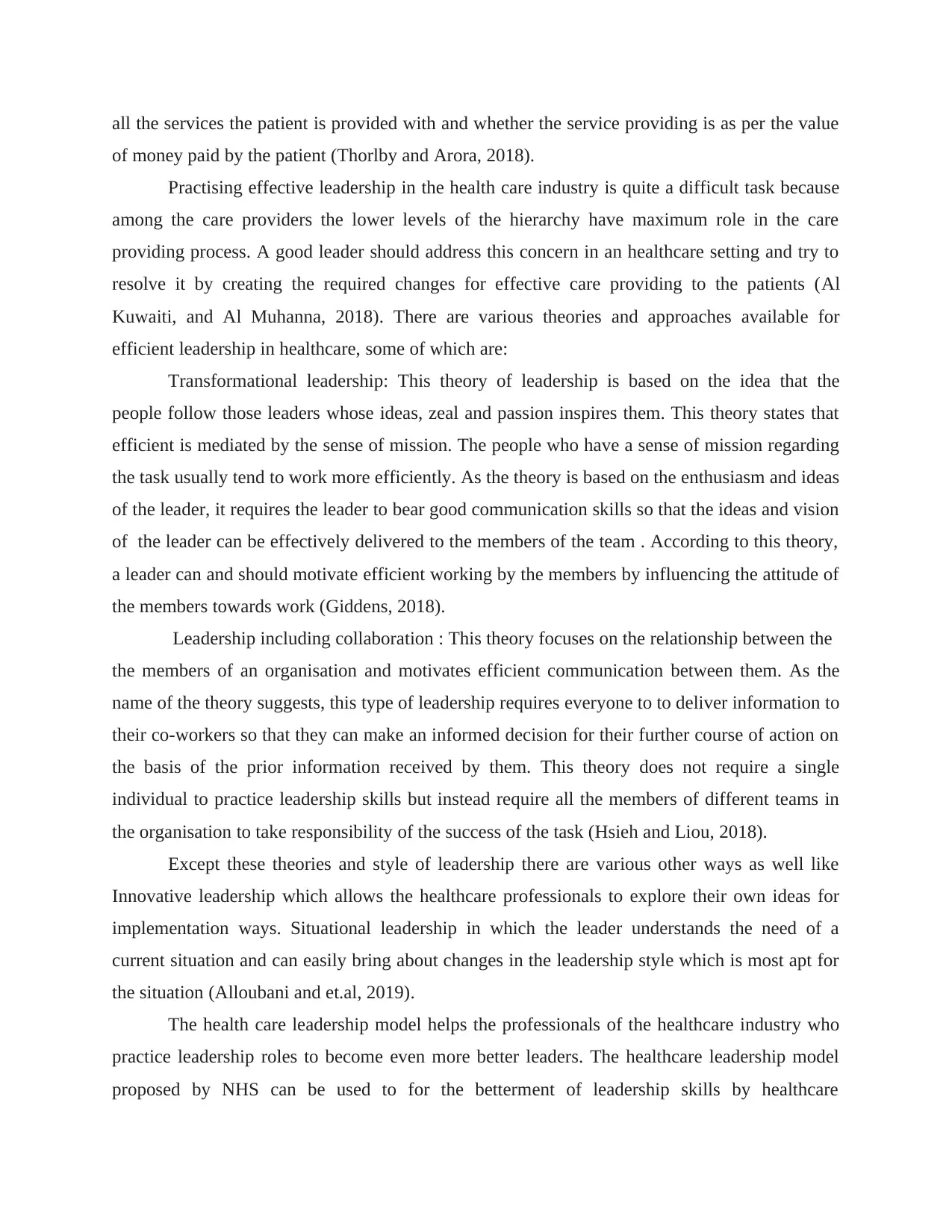
all the services the patient is provided with and whether the service providing is as per the value
of money paid by the patient (Thorlby and Arora, 2018).
Practising effective leadership in the health care industry is quite a difficult task because
among the care providers the lower levels of the hierarchy have maximum role in the care
providing process. A good leader should address this concern in an healthcare setting and try to
resolve it by creating the required changes for effective care providing to the patients (Al
Kuwaiti, and Al Muhanna, 2018). There are various theories and approaches available for
efficient leadership in healthcare, some of which are:
Transformational leadership: This theory of leadership is based on the idea that the
people follow those leaders whose ideas, zeal and passion inspires them. This theory states that
efficient is mediated by the sense of mission. The people who have a sense of mission regarding
the task usually tend to work more efficiently. As the theory is based on the enthusiasm and ideas
of the leader, it requires the leader to bear good communication skills so that the ideas and vision
of the leader can be effectively delivered to the members of the team . According to this theory,
a leader can and should motivate efficient working by the members by influencing the attitude of
the members towards work (Giddens, 2018).
Leadership including collaboration : This theory focuses on the relationship between the
the members of an organisation and motivates efficient communication between them. As the
name of the theory suggests, this type of leadership requires everyone to to deliver information to
their co-workers so that they can make an informed decision for their further course of action on
the basis of the prior information received by them. This theory does not require a single
individual to practice leadership skills but instead require all the members of different teams in
the organisation to take responsibility of the success of the task (Hsieh and Liou, 2018).
Except these theories and style of leadership there are various other ways as well like
Innovative leadership which allows the healthcare professionals to explore their own ideas for
implementation ways. Situational leadership in which the leader understands the need of a
current situation and can easily bring about changes in the leadership style which is most apt for
the situation (Alloubani and et.al, 2019).
The health care leadership model helps the professionals of the healthcare industry who
practice leadership roles to become even more better leaders. The healthcare leadership model
proposed by NHS can be used to for the betterment of leadership skills by healthcare
of money paid by the patient (Thorlby and Arora, 2018).
Practising effective leadership in the health care industry is quite a difficult task because
among the care providers the lower levels of the hierarchy have maximum role in the care
providing process. A good leader should address this concern in an healthcare setting and try to
resolve it by creating the required changes for effective care providing to the patients (Al
Kuwaiti, and Al Muhanna, 2018). There are various theories and approaches available for
efficient leadership in healthcare, some of which are:
Transformational leadership: This theory of leadership is based on the idea that the
people follow those leaders whose ideas, zeal and passion inspires them. This theory states that
efficient is mediated by the sense of mission. The people who have a sense of mission regarding
the task usually tend to work more efficiently. As the theory is based on the enthusiasm and ideas
of the leader, it requires the leader to bear good communication skills so that the ideas and vision
of the leader can be effectively delivered to the members of the team . According to this theory,
a leader can and should motivate efficient working by the members by influencing the attitude of
the members towards work (Giddens, 2018).
Leadership including collaboration : This theory focuses on the relationship between the
the members of an organisation and motivates efficient communication between them. As the
name of the theory suggests, this type of leadership requires everyone to to deliver information to
their co-workers so that they can make an informed decision for their further course of action on
the basis of the prior information received by them. This theory does not require a single
individual to practice leadership skills but instead require all the members of different teams in
the organisation to take responsibility of the success of the task (Hsieh and Liou, 2018).
Except these theories and style of leadership there are various other ways as well like
Innovative leadership which allows the healthcare professionals to explore their own ideas for
implementation ways. Situational leadership in which the leader understands the need of a
current situation and can easily bring about changes in the leadership style which is most apt for
the situation (Alloubani and et.al, 2019).
The health care leadership model helps the professionals of the healthcare industry who
practice leadership roles to become even more better leaders. The healthcare leadership model
proposed by NHS can be used to for the betterment of leadership skills by healthcare
Secure Best Marks with AI Grader
Need help grading? Try our AI Grader for instant feedback on your assignments.
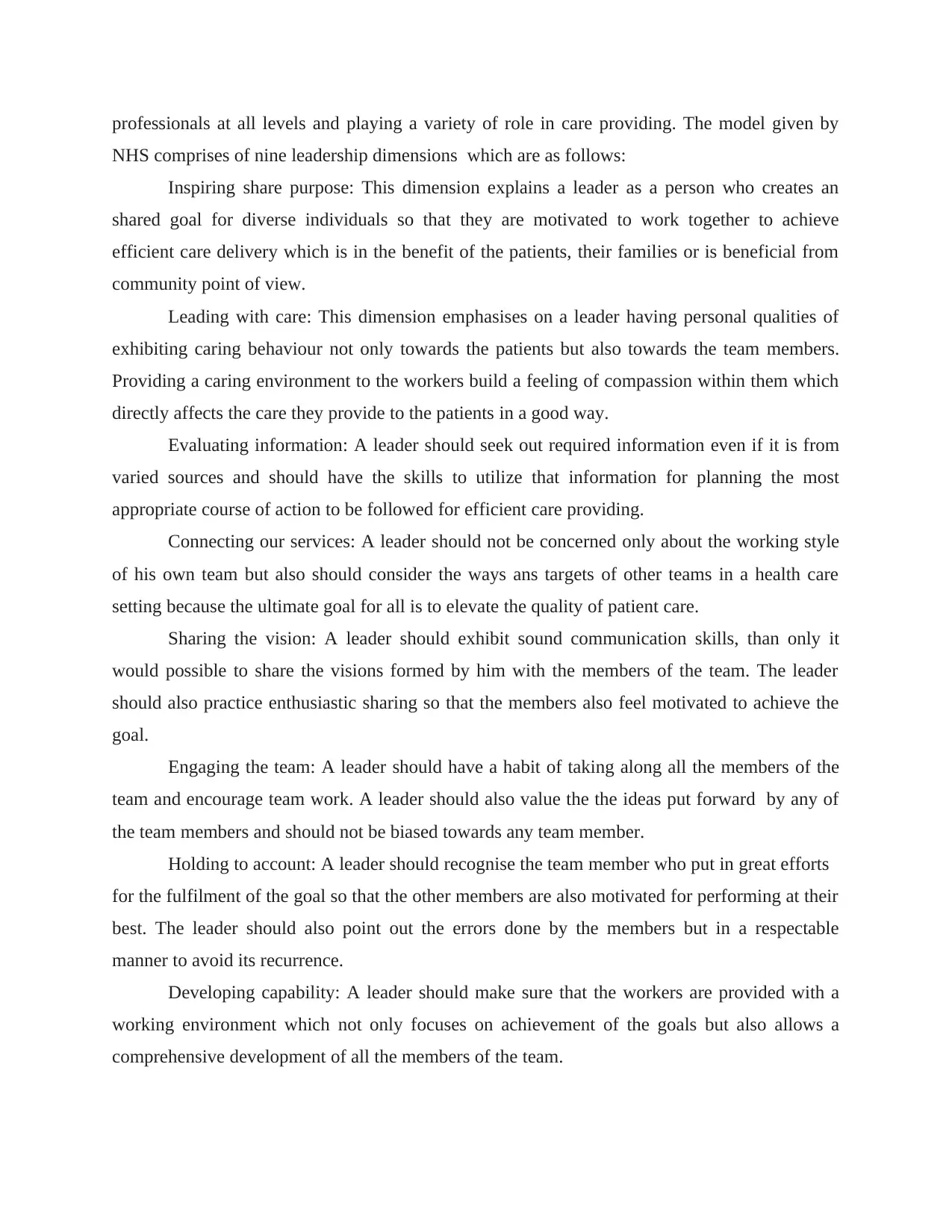
professionals at all levels and playing a variety of role in care providing. The model given by
NHS comprises of nine leadership dimensions which are as follows:
Inspiring share purpose: This dimension explains a leader as a person who creates an
shared goal for diverse individuals so that they are motivated to work together to achieve
efficient care delivery which is in the benefit of the patients, their families or is beneficial from
community point of view.
Leading with care: This dimension emphasises on a leader having personal qualities of
exhibiting caring behaviour not only towards the patients but also towards the team members.
Providing a caring environment to the workers build a feeling of compassion within them which
directly affects the care they provide to the patients in a good way.
Evaluating information: A leader should seek out required information even if it is from
varied sources and should have the skills to utilize that information for planning the most
appropriate course of action to be followed for efficient care providing.
Connecting our services: A leader should not be concerned only about the working style
of his own team but also should consider the ways ans targets of other teams in a health care
setting because the ultimate goal for all is to elevate the quality of patient care.
Sharing the vision: A leader should exhibit sound communication skills, than only it
would possible to share the visions formed by him with the members of the team. The leader
should also practice enthusiastic sharing so that the members also feel motivated to achieve the
goal.
Engaging the team: A leader should have a habit of taking along all the members of the
team and encourage team work. A leader should also value the the ideas put forward by any of
the team members and should not be biased towards any team member.
Holding to account: A leader should recognise the team member who put in great efforts
for the fulfilment of the goal so that the other members are also motivated for performing at their
best. The leader should also point out the errors done by the members but in a respectable
manner to avoid its recurrence.
Developing capability: A leader should make sure that the workers are provided with a
working environment which not only focuses on achievement of the goals but also allows a
comprehensive development of all the members of the team.
NHS comprises of nine leadership dimensions which are as follows:
Inspiring share purpose: This dimension explains a leader as a person who creates an
shared goal for diverse individuals so that they are motivated to work together to achieve
efficient care delivery which is in the benefit of the patients, their families or is beneficial from
community point of view.
Leading with care: This dimension emphasises on a leader having personal qualities of
exhibiting caring behaviour not only towards the patients but also towards the team members.
Providing a caring environment to the workers build a feeling of compassion within them which
directly affects the care they provide to the patients in a good way.
Evaluating information: A leader should seek out required information even if it is from
varied sources and should have the skills to utilize that information for planning the most
appropriate course of action to be followed for efficient care providing.
Connecting our services: A leader should not be concerned only about the working style
of his own team but also should consider the ways ans targets of other teams in a health care
setting because the ultimate goal for all is to elevate the quality of patient care.
Sharing the vision: A leader should exhibit sound communication skills, than only it
would possible to share the visions formed by him with the members of the team. The leader
should also practice enthusiastic sharing so that the members also feel motivated to achieve the
goal.
Engaging the team: A leader should have a habit of taking along all the members of the
team and encourage team work. A leader should also value the the ideas put forward by any of
the team members and should not be biased towards any team member.
Holding to account: A leader should recognise the team member who put in great efforts
for the fulfilment of the goal so that the other members are also motivated for performing at their
best. The leader should also point out the errors done by the members but in a respectable
manner to avoid its recurrence.
Developing capability: A leader should make sure that the workers are provided with a
working environment which not only focuses on achievement of the goals but also allows a
comprehensive development of all the members of the team.
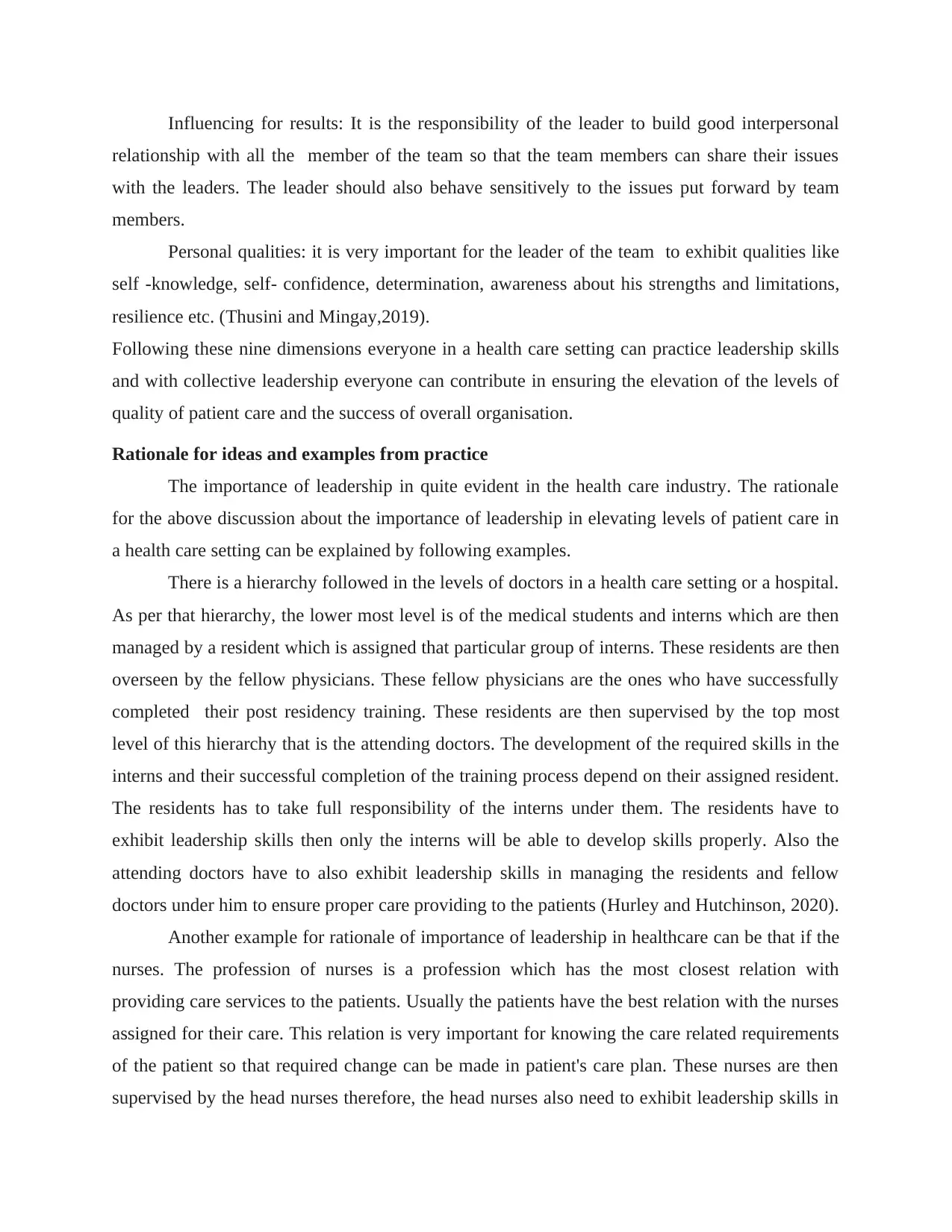
Influencing for results: It is the responsibility of the leader to build good interpersonal
relationship with all the member of the team so that the team members can share their issues
with the leaders. The leader should also behave sensitively to the issues put forward by team
members.
Personal qualities: it is very important for the leader of the team to exhibit qualities like
self -knowledge, self- confidence, determination, awareness about his strengths and limitations,
resilience etc. (Thusini and Mingay,2019).
Following these nine dimensions everyone in a health care setting can practice leadership skills
and with collective leadership everyone can contribute in ensuring the elevation of the levels of
quality of patient care and the success of overall organisation.
Rationale for ideas and examples from practice
The importance of leadership in quite evident in the health care industry. The rationale
for the above discussion about the importance of leadership in elevating levels of patient care in
a health care setting can be explained by following examples.
There is a hierarchy followed in the levels of doctors in a health care setting or a hospital.
As per that hierarchy, the lower most level is of the medical students and interns which are then
managed by a resident which is assigned that particular group of interns. These residents are then
overseen by the fellow physicians. These fellow physicians are the ones who have successfully
completed their post residency training. These residents are then supervised by the top most
level of this hierarchy that is the attending doctors. The development of the required skills in the
interns and their successful completion of the training process depend on their assigned resident.
The residents has to take full responsibility of the interns under them. The residents have to
exhibit leadership skills then only the interns will be able to develop skills properly. Also the
attending doctors have to also exhibit leadership skills in managing the residents and fellow
doctors under him to ensure proper care providing to the patients (Hurley and Hutchinson, 2020).
Another example for rationale of importance of leadership in healthcare can be that if the
nurses. The profession of nurses is a profession which has the most closest relation with
providing care services to the patients. Usually the patients have the best relation with the nurses
assigned for their care. This relation is very important for knowing the care related requirements
of the patient so that required change can be made in patient's care plan. These nurses are then
supervised by the head nurses therefore, the head nurses also need to exhibit leadership skills in
relationship with all the member of the team so that the team members can share their issues
with the leaders. The leader should also behave sensitively to the issues put forward by team
members.
Personal qualities: it is very important for the leader of the team to exhibit qualities like
self -knowledge, self- confidence, determination, awareness about his strengths and limitations,
resilience etc. (Thusini and Mingay,2019).
Following these nine dimensions everyone in a health care setting can practice leadership skills
and with collective leadership everyone can contribute in ensuring the elevation of the levels of
quality of patient care and the success of overall organisation.
Rationale for ideas and examples from practice
The importance of leadership in quite evident in the health care industry. The rationale
for the above discussion about the importance of leadership in elevating levels of patient care in
a health care setting can be explained by following examples.
There is a hierarchy followed in the levels of doctors in a health care setting or a hospital.
As per that hierarchy, the lower most level is of the medical students and interns which are then
managed by a resident which is assigned that particular group of interns. These residents are then
overseen by the fellow physicians. These fellow physicians are the ones who have successfully
completed their post residency training. These residents are then supervised by the top most
level of this hierarchy that is the attending doctors. The development of the required skills in the
interns and their successful completion of the training process depend on their assigned resident.
The residents has to take full responsibility of the interns under them. The residents have to
exhibit leadership skills then only the interns will be able to develop skills properly. Also the
attending doctors have to also exhibit leadership skills in managing the residents and fellow
doctors under him to ensure proper care providing to the patients (Hurley and Hutchinson, 2020).
Another example for rationale of importance of leadership in healthcare can be that if the
nurses. The profession of nurses is a profession which has the most closest relation with
providing care services to the patients. Usually the patients have the best relation with the nurses
assigned for their care. This relation is very important for knowing the care related requirements
of the patient so that required change can be made in patient's care plan. These nurses are then
supervised by the head nurses therefore, the head nurses also need to exhibit leadership skills in
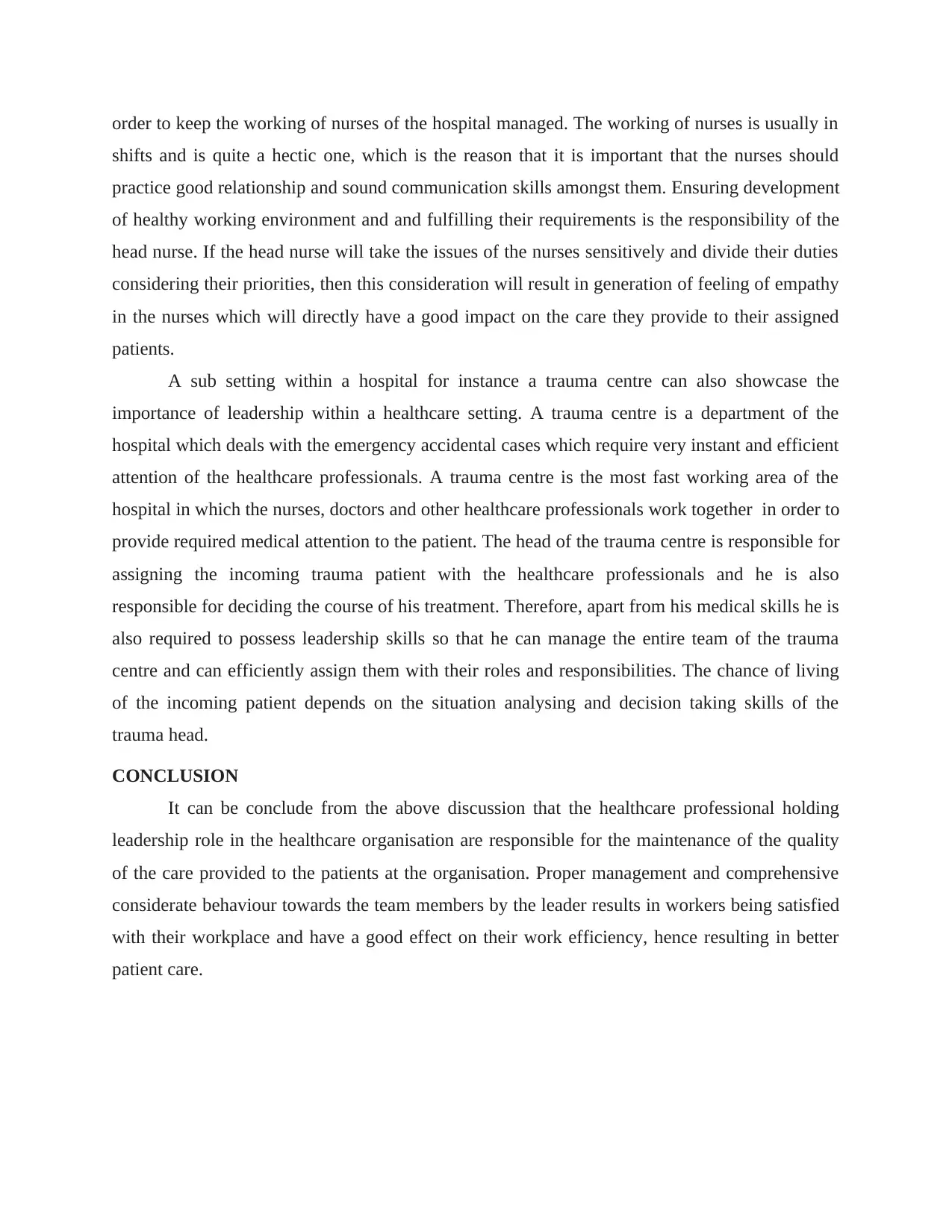
order to keep the working of nurses of the hospital managed. The working of nurses is usually in
shifts and is quite a hectic one, which is the reason that it is important that the nurses should
practice good relationship and sound communication skills amongst them. Ensuring development
of healthy working environment and and fulfilling their requirements is the responsibility of the
head nurse. If the head nurse will take the issues of the nurses sensitively and divide their duties
considering their priorities, then this consideration will result in generation of feeling of empathy
in the nurses which will directly have a good impact on the care they provide to their assigned
patients.
A sub setting within a hospital for instance a trauma centre can also showcase the
importance of leadership within a healthcare setting. A trauma centre is a department of the
hospital which deals with the emergency accidental cases which require very instant and efficient
attention of the healthcare professionals. A trauma centre is the most fast working area of the
hospital in which the nurses, doctors and other healthcare professionals work together in order to
provide required medical attention to the patient. The head of the trauma centre is responsible for
assigning the incoming trauma patient with the healthcare professionals and he is also
responsible for deciding the course of his treatment. Therefore, apart from his medical skills he is
also required to possess leadership skills so that he can manage the entire team of the trauma
centre and can efficiently assign them with their roles and responsibilities. The chance of living
of the incoming patient depends on the situation analysing and decision taking skills of the
trauma head.
CONCLUSION
It can be conclude from the above discussion that the healthcare professional holding
leadership role in the healthcare organisation are responsible for the maintenance of the quality
of the care provided to the patients at the organisation. Proper management and comprehensive
considerate behaviour towards the team members by the leader results in workers being satisfied
with their workplace and have a good effect on their work efficiency, hence resulting in better
patient care.
shifts and is quite a hectic one, which is the reason that it is important that the nurses should
practice good relationship and sound communication skills amongst them. Ensuring development
of healthy working environment and and fulfilling their requirements is the responsibility of the
head nurse. If the head nurse will take the issues of the nurses sensitively and divide their duties
considering their priorities, then this consideration will result in generation of feeling of empathy
in the nurses which will directly have a good impact on the care they provide to their assigned
patients.
A sub setting within a hospital for instance a trauma centre can also showcase the
importance of leadership within a healthcare setting. A trauma centre is a department of the
hospital which deals with the emergency accidental cases which require very instant and efficient
attention of the healthcare professionals. A trauma centre is the most fast working area of the
hospital in which the nurses, doctors and other healthcare professionals work together in order to
provide required medical attention to the patient. The head of the trauma centre is responsible for
assigning the incoming trauma patient with the healthcare professionals and he is also
responsible for deciding the course of his treatment. Therefore, apart from his medical skills he is
also required to possess leadership skills so that he can manage the entire team of the trauma
centre and can efficiently assign them with their roles and responsibilities. The chance of living
of the incoming patient depends on the situation analysing and decision taking skills of the
trauma head.
CONCLUSION
It can be conclude from the above discussion that the healthcare professional holding
leadership role in the healthcare organisation are responsible for the maintenance of the quality
of the care provided to the patients at the organisation. Proper management and comprehensive
considerate behaviour towards the team members by the leader results in workers being satisfied
with their workplace and have a good effect on their work efficiency, hence resulting in better
patient care.
Paraphrase This Document
Need a fresh take? Get an instant paraphrase of this document with our AI Paraphraser
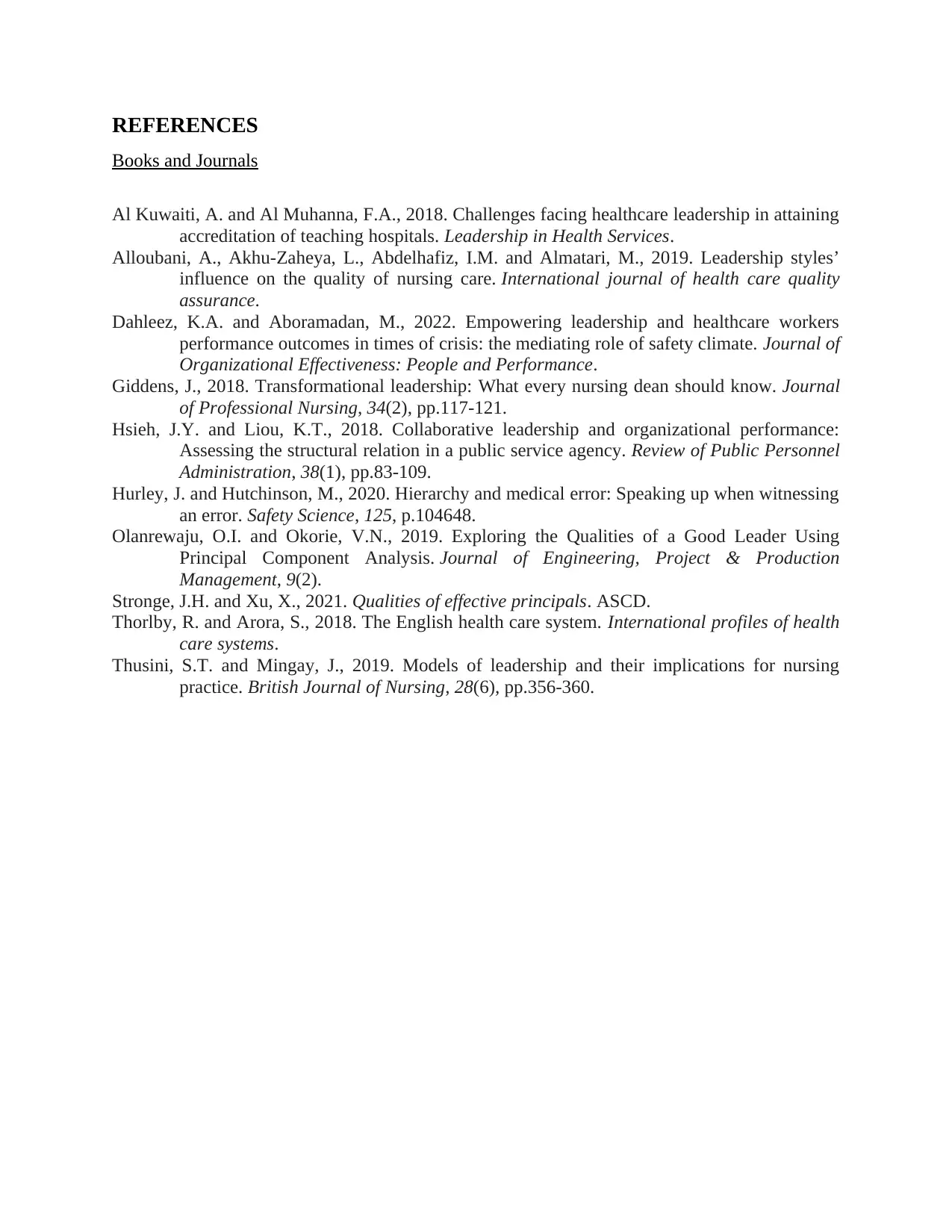
REFERENCES
Books and Journals
Al Kuwaiti, A. and Al Muhanna, F.A., 2018. Challenges facing healthcare leadership in attaining
accreditation of teaching hospitals. Leadership in Health Services.
Alloubani, A., Akhu-Zaheya, L., Abdelhafiz, I.M. and Almatari, M., 2019. Leadership styles’
influence on the quality of nursing care. International journal of health care quality
assurance.
Dahleez, K.A. and Aboramadan, M., 2022. Empowering leadership and healthcare workers
performance outcomes in times of crisis: the mediating role of safety climate. Journal of
Organizational Effectiveness: People and Performance.
Giddens, J., 2018. Transformational leadership: What every nursing dean should know. Journal
of Professional Nursing, 34(2), pp.117-121.
Hsieh, J.Y. and Liou, K.T., 2018. Collaborative leadership and organizational performance:
Assessing the structural relation in a public service agency. Review of Public Personnel
Administration, 38(1), pp.83-109.
Hurley, J. and Hutchinson, M., 2020. Hierarchy and medical error: Speaking up when witnessing
an error. Safety Science, 125, p.104648.
Olanrewaju, O.I. and Okorie, V.N., 2019. Exploring the Qualities of a Good Leader Using
Principal Component Analysis. Journal of Engineering, Project & Production
Management, 9(2).
Stronge, J.H. and Xu, X., 2021. Qualities of effective principals. ASCD.
Thorlby, R. and Arora, S., 2018. The English health care system. International profiles of health
care systems.
Thusini, S.T. and Mingay, J., 2019. Models of leadership and their implications for nursing
practice. British Journal of Nursing, 28(6), pp.356-360.
Books and Journals
Al Kuwaiti, A. and Al Muhanna, F.A., 2018. Challenges facing healthcare leadership in attaining
accreditation of teaching hospitals. Leadership in Health Services.
Alloubani, A., Akhu-Zaheya, L., Abdelhafiz, I.M. and Almatari, M., 2019. Leadership styles’
influence on the quality of nursing care. International journal of health care quality
assurance.
Dahleez, K.A. and Aboramadan, M., 2022. Empowering leadership and healthcare workers
performance outcomes in times of crisis: the mediating role of safety climate. Journal of
Organizational Effectiveness: People and Performance.
Giddens, J., 2018. Transformational leadership: What every nursing dean should know. Journal
of Professional Nursing, 34(2), pp.117-121.
Hsieh, J.Y. and Liou, K.T., 2018. Collaborative leadership and organizational performance:
Assessing the structural relation in a public service agency. Review of Public Personnel
Administration, 38(1), pp.83-109.
Hurley, J. and Hutchinson, M., 2020. Hierarchy and medical error: Speaking up when witnessing
an error. Safety Science, 125, p.104648.
Olanrewaju, O.I. and Okorie, V.N., 2019. Exploring the Qualities of a Good Leader Using
Principal Component Analysis. Journal of Engineering, Project & Production
Management, 9(2).
Stronge, J.H. and Xu, X., 2021. Qualities of effective principals. ASCD.
Thorlby, R. and Arora, S., 2018. The English health care system. International profiles of health
care systems.
Thusini, S.T. and Mingay, J., 2019. Models of leadership and their implications for nursing
practice. British Journal of Nursing, 28(6), pp.356-360.
1 out of 8
Related Documents
Your All-in-One AI-Powered Toolkit for Academic Success.
+13062052269
info@desklib.com
Available 24*7 on WhatsApp / Email
![[object Object]](/_next/static/media/star-bottom.7253800d.svg)
Unlock your academic potential
© 2024 | Zucol Services PVT LTD | All rights reserved.




